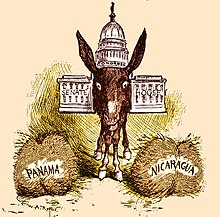
Back Asno de Buridán AN حمار بوريدان Arabic Esl vom Buridan BAR Бурыданаў асёл BE-X-OLD Буриданово магаре Bulgarian Ase de Buridan Catalan Asinu di Buridanu Corsican Buridanův osel Czech Buridans æsel Danish Buridans Esel German

Buridan's ass is an illustration of a paradox in philosophy in the conception of free will. It refers to a hypothetical situation wherein an ass (donkey) that is equally hungry and thirsty is placed precisely midway between a stack of hay and a pail of water. Since the paradox assumes the donkey will always go to whichever is closer, it dies of both hunger and thirst since it cannot make any rational decision between the hay and water.[1] A common variant of the paradox substitutes the hay and water for two identical piles of hay; the ass, unable to choose between the two, dies of hunger.
The paradox is named after the 14th-century French philosopher Jean Buridan, whose philosophy of moral determinism it satirizes. Although the illustration is named after Buridan, philosophers have discussed the concept before him, notably Aristotle, who put forward the example of a man equally hungry and thirsty,[2] and Al-Ghazali, who used a man faced with the choice of equally good dates.[3]
A version of this situation appears as metastability in digital electronics, when a circuit must decide between two states based on an input that is in itself undefined (neither zero nor one). Metastability becomes a problem if the circuit spends more time than it should in this "undecided" state, which is usually set by the speed of the clock the system is using.
- ^ "Buridan's ass: Oxford Companion to Phrase and Fable". Encyclopedia.com. Retrieved 2009-12-15.
- ^ "On The Heavens, Book 2 Part 13.III". Internet Classics Archive. Retrieved 16 April 2024.
- ^ Cite error: The named reference
Kanewas invoked but never defined (see the help page).